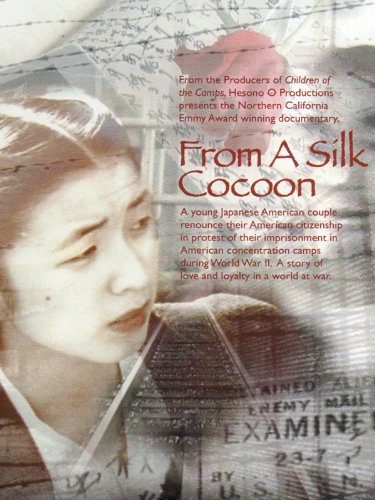From a Silk Cocoon (film)
Documentary film recounting the wartime story of a Kibei couple, Itaru and Shizuko Ina and their two young children as reconstructed by their daughter Satsuki Ina. Ina and co-directors Emery Clay III and Stephen Holsapple tell the story largely through the couple's own words in the form of Shizuko's diary and letters to each other when they become separated in the course of their incarceration.
Synopsis
Satsuki Ina begins the story by recounting her discovery of her parents' documents and photographs in a box. She briefly narrates their early lives: Shizuko was born in rural Washington, but after her mother died when she was three, Shizuko was sent to Japan to be raised by her maternal grandmother. Called back to the U.S. at age 13, she returned to Japan after graduating high school to care for her grandmother. Itaru was born in San Francisco, but his mother took him to Japan where he was largely raised. He returned to the U.S. at age 13. When Shizuko is selected as a "silk girl" representing Japan at the 1939 Pan Pacific Exposition in San Francisco, a family friend introduces her to Itaru. The couple fall in love and soon decide to get married. Letters between the couple capture this moment that leads to their marriage in San Francisco in March 1941.
Shizuko's diary records her misgivings over the growing tensions between Japan and the U.S. and the run up to war, and eventually, the mass forced removal of Japanese Americans. Adding to the travails of her removal and incarceration is her pregnancy. She describes conditions first at Tanforan Assembly Center and then at Topaz , where son Kiyoshi is born in December 1942. When the loyalty questionnaire is circulated in early 1943, Itaru becomes a leader of efforts to protest the questionnaire, citing their rights as American citizens. This makes him a marked man, and he is eventually charged with sedition. The family is sent to Tule Lake in September 1943 where festering anger and recurrent bouts of poor health push them towards Japan. A second child, Satsuki, is born in Tule Lake. Later, Itaru is taken out of Tule Lake and sent to the Bismarck, North Dakota , internment camp, while Shizuko and the children remain at Tule Lake. Letters between the couple recount their decision to renounce their U.S. citizenship and to return to Japan. Though their resolve to return remains strong even after the war ends, reports on the terrible conditions in Japan lead them to reconsider in the interest of the two young children. But rumors that they may be deported anyway further discourage them, even as the family reunites at the Crystal City internment camp in April 1946.
Voice actors—Megumi for Shizuko and Lane Nishikawa for Itaru—tell much of the story in their own words. Satsuki Ina and narrator Lawson Inada fill in other parts of the story. In addition to family photographs and archival stills and video, key scenes are silently recreated by actors (Kimberly Ina as Shizuko and Christopher Sato Wong as Itaru).
Background and Reception
Filmmaker Satsuki Ina is a psychotherapist and emeritus professor at California State University, Sacramento. When she saw a picture of her father in the Tule Lake stockade in the Smithsonian Institution's " A More Perfect Union: Japanese Americans and the U.S. Constitution " exhibition, she became determined to learn more about her family's history. After her father's passing in 1977, she found her mother's letters to him among his possessions. After her mother's passing in 2000, she found his letters to her along with her diary. Working with much of the same team that worked on her prior film, Children of the Camps (1999), Ina and co-directors Stephen Holsapple and Emery Clay III began production in 2003 with the aid of funding from California Civil Liberties Public Education Program grant and from the Center for Asian American Media. It premiered at the Crest Theatre in Sacramento in February 2005 and has subsequently screened around the country. Among other awards, From a Silk Cocoon won Emmy Awards in the Historical/Cultural Program category from the National Academy of Television Arts and Sciences, San Francisco/Northern California Chapter in 2006.
Might also like Resistance at Tule Lake (2016); Rabbit in the Moon (1999); Children of the Camps (1999)
| Release Date | 2005 |
|---|---|
| Runtime | 57 minutes |
| Director | Emery Clay III |
| Producer | Satsuki Ina |
| Writer | Satsuki Ina |
| Narrator | Lawson Fusao Inada |
| Starring | Satsuki Ina (storyteller), Lane Nishikawa (voice of Itaru), Megumi (voice of Shizuko), Kimberly Ina (Shizuko), Christopher Sato Wong (Itaru) |
| Music | Masayuki Koga |
| Cinematography | Stephen Holsapple |
| Studio | Hesono O Productions |
| Distributor | Center for Asian American Media |
| IMDB Link | http://www.imdb.com/title/tt1454982/ |
For More Information
Official website: http://www.fromasilkcocoon.com/index.html .
Center for Asian American Media website: http://caamedia.org/films/from-a-silk-cocoon/ .
Halverson, Mark. " Lest We Forget History. " Sacramento News & Review , Feb. 17, 2005.
Jeffs, Angela. " Award-Winning Docudrama 'From a Silk Cocoon,' ." The Japan Times , Sept. 23, 2006.
